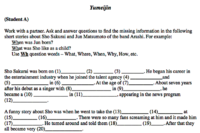
One of the most common mistakes teachers encounter with beginner level university students is with their inability to use the simple past tense correctly. This lesson addresses that issue and it also gets students to use WH-question words correctly. It is called Yumeijin (Famous person). It is best to provide and use information gap activities whenever possible because it brings students together to accomplish a specific task. In this activity, students are presented with information about the lives of two famous Japanese celebrities and in pairs they will work together to determine the missing information. The missing information will elicit responses using the simple past tense and the use of WH-question words. A more detailed description of this activity is listed in the Teacher’s Notes.
